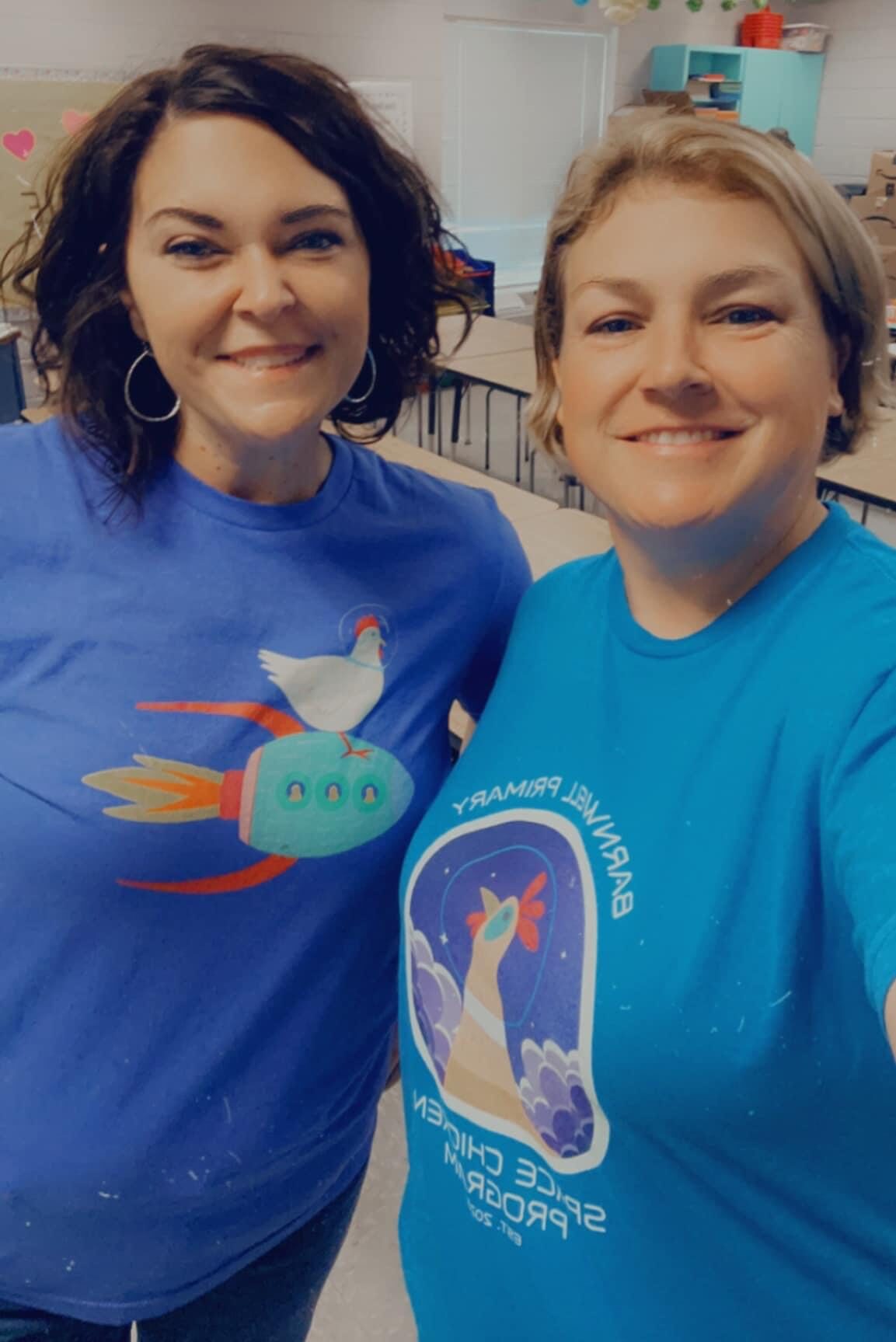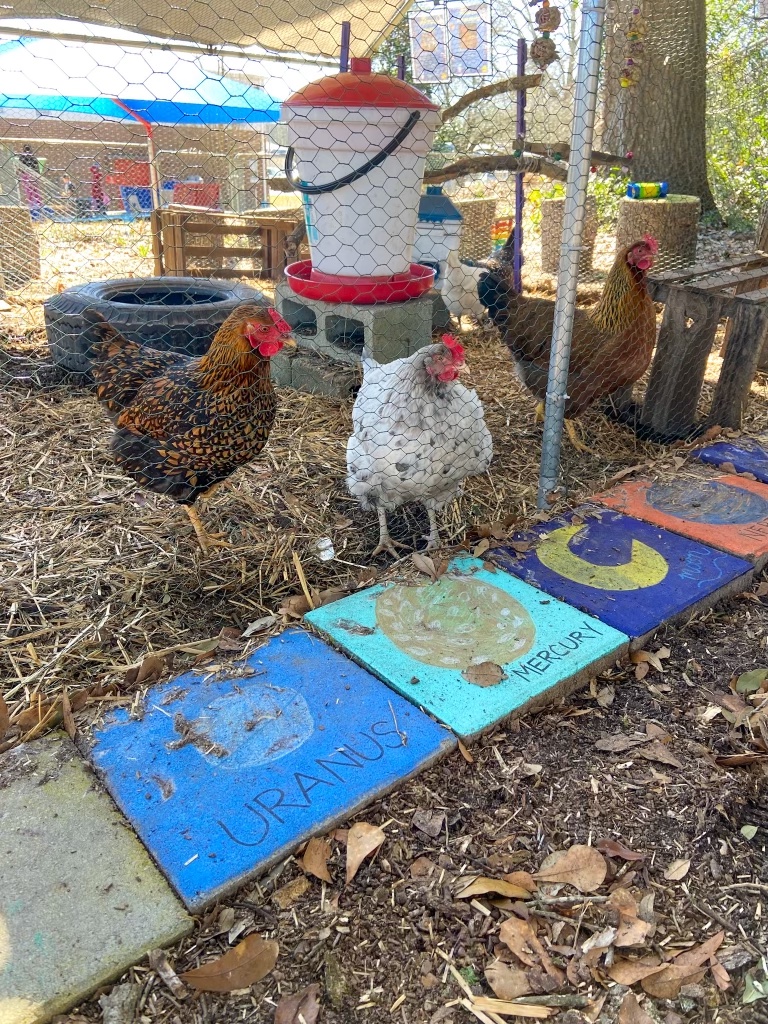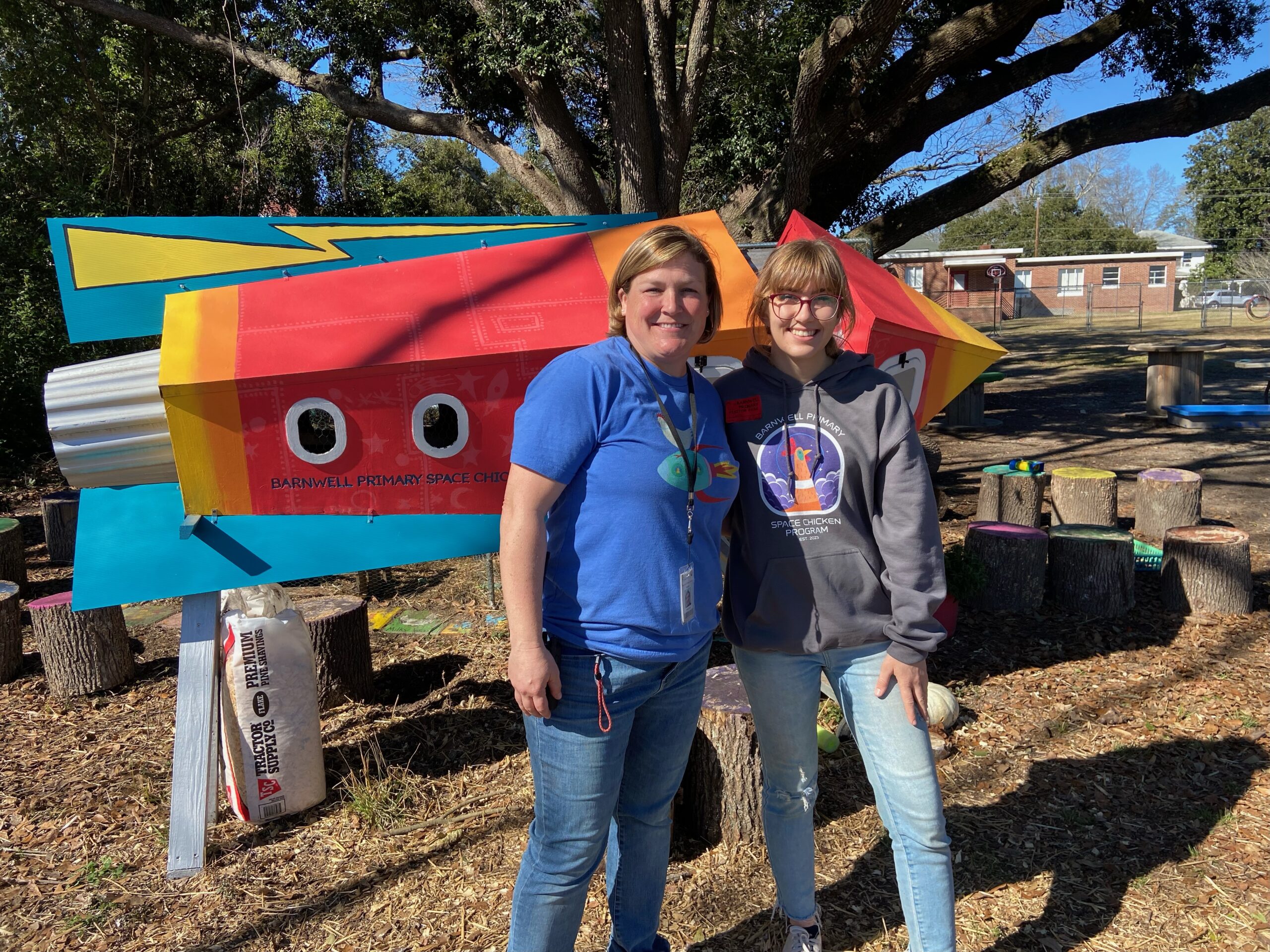Creating a Space for Learning with Chickens:
A Tour of Barnwell Primary’s Chicken Space Coop and Outdoor Classroom
September 2024 | Molly Sutton
Space Chickens have landed at Barnwell Primary School!
Barnwell Primary School’s Space Chicken Program is a shining example of what a school chicken coop & garden can look like under exemplary and creative leadership.
The story below outlines Emily Coble’s journey to creating a thriving space-themed chicken program at her school in South Carolina. We will share steps she took to gain school board approval, find funding, and the building process. Furthermore, we discuss how she continues to engage students and the surrounding community in this unique educational experience.
Key Takeaways:
Creative Funding
Engaging Design
Student Involvement
In a galaxy not so far away, Space Chickens have just landed and are reporting for duty as the day starts at Barnwell Primary School in South Carolina. Students and teachers alike travel from homerooms to visit their celestial friends in an impressive outdoor classroom. Here, chickens are used as therapy animals in play, and gardening is taught as a science.
In 2023, Physical Education teacher, Emily Coble set out to raise chickens at her school. Like other schools who raise chickens, she sought to improve STEM education and engage students outdoors. How did she make this dream happen? Through an art grant, surprisingly!
“It’s kind of a slow process,” Emily tells us about getting approval and funding to raise chickens at her school. “I wanted to do it like two or three years ago and I just was super busy. It got approved and then I just didn’t really have the time to get all the funding and things. The next year, I revisited [the project] and then I had to write another proposal for it which [the school board] was on board with. So, then it was, ‘Get your grant funded!’”

Finding Funding
Unsurprisingly, finding funding to set up a school chicken coop and garden did not happen overnight. “I did a lot of research because I had to do the proposal, and just tried to figure out what could I fit in my budget as far as like housing for them,” recalled Emily. Usually, the coop is the most expensive part of raising school chickens, and Emily found a very creative way to pay for theirs!
“We got the coop through an Artist in Residence Grant,” Emily told us. This type of government grant is for public schools to invite teaching artists to lead educational arts experiences. This is different from an “artisan residence grant,” which is usually created by a community of artists and bestowed upon a single artist to hone their skills. The idea to use this unconventional funding method to build a chicken coop came from Emily’s close friend, Bob Snead—a local artist and President/CEO of the Southern Palmetto Regional Chamber of Commerce. “This guy can do anything,” Emily doted. “We were at dinner one night he came up with this. I told him we wanted a chicken coop he’s like, ‘Okay, space chickens,’ and we ran with it!” And with that, the Space Chicken Program had launched!
Barnwell Primary’s chicken coop and garden project has had many funding sources, including:
-
-
An Artist in Residence grant to build a chicken coop.
-
Physical and monetary donations from farms, nurseries and local community members (incubator, chickens, soil, compost, plants, and more).
-
Grant from the South Carolina Department of Health and Environmental Control (DHEC)* for compost setup. *This department has split into two separate entities, the South Carolina Department of Environmental Services (SCDES) and the South Carolina Department of Public Health (DPH).
-
Spring fundraiser: strawberry baskets, salad green baskets, herb gardens, and flower baskets. Goes in school newsletter and parents buy them, but also opens to community.
-
Ongoing fundraiser: Space Chicken t-shirts and sweatshirts sale. The design is cute, so obviously people want to wear these!
-
Building the Coop
Effectively, the grant allowed Snead to design, purchase materials and build the spaceship design of the chicken coop. “He came and did the whole process with the kids. He even started with like a 3D model, and the kids were a part of every single process.” In preparation for the build, Snead manufactured parts for the spaceship out of wood (mostly). He then spent time assembling the coop at the school with children. “He was here for an entire week and each class got to come out and help be a part of it at least twice,” Emily recalls. Snead and Coble ensured students were included in every step of the process, painting and helping to assemble pre-cut parts.
Click the arrows to view different images of the chicken coop!
Details in Barnwell’s Outdoor Classroom
Walking around Barnwell Primary School’s outdoor classroom, unquestionably an artist helped create the space. Color is everywhere, engaging students and highlighting areas intended for play and exploration. Chickens can roam free around play stations and in the garden, enticing children to follow and completely use the space. Overall, this layout provides simple solutions to play, security and practicality, but the design elements add a sense of whimsy, creating a more impactful learning environment.
The Chicken Area
Painted rocks further add to the space chicken theme, scattering cosmic sprinkles around the garden for students to enjoy.

Use of Signs
Signs are posted on the chicken run with a photo of each chicken, their name, and a little about their breeds. Also exhibited on the chicken run is a sign displaying rules for interacting with the space chickens. Similarly, in the garden a large sign can be found highlighting expectations for students in the space.
The Garden
Although the space chicken theme does not continue from the coop into Barnwell’s garden, space-like technology is still utilized. Students use recycled materials and vertical space to efficiently grow food. Soil and compost is donated by a local farm, Humble Acres in Blackville, SC. They also have plant starts donated from local nurseries. When planting with seeds, Emily opts to use seed tape, “because it’s just easier for the little fingers.” Even with chickens free ranging daily, the garden looks beautiful!
Click the arrows to view more images of Barnwell’s garden!
Composting
Barnwell is starting a new composting program, after receiving a grant from the South Carolina Department of Health and Environmental Control (DHEC). After lunch, food scraps are collected for the compost bin, and whatever sealed leftovers remain go into their “food share.” Students may take food from the food share later. But of course, some of the food share is shared with chickens for “chicken salad” to supplement their feed. Food scraps go to the chickens or compost bins.
The school even has a designated paper shredder to break down paper from classrooms for the compost! This year, Emily will even attempt to use it as bedding for the chickens to save money.
Using the Outdoor Classroom
Part of what makes Barnwell’s chicken coop and garden program spectacular is the involvement of students in every process. Highlighted above, students were able to help with every step of building the spaceship coop. They are tasked with daily chores, like feeding treats to the chickens and collecting eggs. Additionally, hands-on play and free reign of the space helps students feel a sense of ownership over the program. Although chickens have not yet started to make an appearance in classrooms for lessons (yet!), many learning opportunities with chickens present themselves outdoors.
As a PE teacher, finding ways to incorporate exercise into learning is a passion of Emily’s. “The kids love it,” she explains, “I mean they do, and it’s different. They need to not be sitting in a desk all day, you know, and I mean, I know that’s what we have to do, but they don’t have to do that when they come here.” Students often have free time with the chickens, learning responsibility through creative play with the flock, and taking time to decompress from the stress of classes.
Read Across America Week
One special event that takes place in the outdoor classroom is a celebration for Read Across America Week (Mar. 2-6). Starting on the late Dr. Seuss’s birthday, students across the country celebrate the joys of reading in different ways. Some host reading challenges, fundraisers, and even have live reading sessions! At Barnwell Primary, students get to spend class time outside, reading with the chickens. “We have lots of different flexible seating options in our barn,” Emily describes, “but they will come out and read to the chickens.”
Community Engagement and Program Sustainability
Involving the Community
The playful design of the space is only half of what makes this school chicken coop and garden so successful. The other half of this program’s prosperity comes from Emily’s ability to engage the school and surrounding communities. “I have parents that are commenting like, ‘How do I get my kid involved in this?’ and I’m like, ‘sign them up for school!’” Many community members closely follow Barnwell Primary’s Space Chicken Facebook group to stay up to date on coop news. Emily will post exciting chicken news, action shots of kids in the garden, and garden events. One such event is a spring fundraiser where students create and sell hanging basket arrangements to support their program. This year’s wares included strawberry baskets, mixed greens baskets, herb gardens, and flower baskets.
Space Chickens Reaching for the Moon
The Space Chicken Program at Barnwell Primary has truly had a domino effect. Students who have moved on from the school have been trying to get their new schools to raise chickens. Just down the street from the school is a community garden for Barnwell residents, started by Bob Snead’s wife, Dawn. Dawn (who happens to also be Emily’s close friend) runs Barnwell Farmer’s Market which has fantastic kid’s programs about once a month. Emily hopes to see the community garden raise chickens one day, so non-student community members can have access to the benefits of raising chickens. “We’ll see, maybe we’ll get them on board. We could build on the space chicken thing and build a moon coop or something.”
As far as next steps for Barnwell chickens, Emily hopes to use their new incubator in the 2024-2025 school year. She would also like to create a larger, more permeant chicken run as she continues to fine-tune their composting program.
Final Thoughts
Barnwell Primary School’s Space Chicken program is truly a model schools across the country should follow when implementing school chicken coops and gardens. Bob Snead’s spaceship design proves that chicken coops don’t have to be boring, and a little bit of creativity can go miles to improving community engagement and support of a school chicken program. Although Emily Coble worked hard to secure grants to fund the initial setup of the chicken area, she validates that a school chicken program can be sustainable through fundraising. We look forward to seeing how this program grows in Barnwell county!
Final advice from Emily Coble on starting a school coop:
“Reach out to people that you know. If you have no knowledge of chicken keeping then you’re definitely going to need somebody that’s going to be on board with you to help in that! I was lucky I had that knowledge, but if not, find someone who does. Local extension offices usually can help.”
“Donors Choose is great choice for the funding part, but yeah you’re gonna need some help. Google is your friend! Get some stakeholders involved the parents get really excited about it so get a couple parents to help. There’s lots of good resources out there, and you’ve got to find the resources. You can’t do it all by yourself, that’s for sure, unless you are really wealthy or you have a great donor.”
Do you wish to discuss Barnwell’s space chicken program more? Emily Coble is happy to speak with you! Contact us get in touch.
























0 Comments